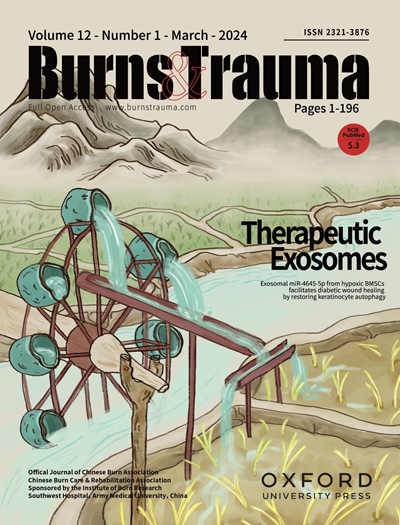一种多功能双氢杨梅素负载水凝胶,用于糖尿病伤口愈合和血糖控制的顺序调节
IF 9.6
1区 医学
Q1 DERMATOLOGY
引用次数: 0
摘要
背景慢性糖尿病伤口的处理在临床实践中仍然是一个艰巨的挑战。持续的高血糖会引发血管病变、神经病变和免疫功能障碍,严重阻碍伤口修复。我们开发了一种多功能水凝胶(DPFI),设计用于顺序治疗作用,包括抗菌,抗炎,抗氧化,促血管生成/上皮化和血糖调节特性,以解决这些并发症。方法将二氢杨梅素(DMY)包封在醛功能化的Pluronic F127胶束(DMY@PF127-CHO)中,与富胺聚乙烯亚胺(PEI)发生席夫碱反应,形成可控释药物的水凝胶。使用各种技术评估水凝胶的抗菌、抗氧化、抗炎、促细胞增殖和血管生成特性,包括结构表征、细菌活/死染色、活性氧(ROS)测定、抗氧化酶测定、逆转录聚合酶链反应(RT-PCR)、细胞免疫荧光染色、划伤愈合测定和血管生成测定。在体内,水凝胶对mrsa感染的链脲佐菌素诱导的糖尿病小鼠的伤口愈合和血糖控制的影响进行了评估。结果该水凝胶具有良好的可注射性、生物黏附性和自愈性,有利于DMY的可控缓释,可与PEI协同增强抗菌效果。DMY的抗氧化活性显著;它能有效清除活性氧(ROS),诱导抗氧化酶的表达,同时促进M1巨噬细胞向M2巨噬细胞的表型转换,从而减轻炎症。重要的是,DPFI还有助于血糖调节,减少高血糖相关并发症,并创造有利于伤口修复的微环境。全面的体外和体内分析证实了DPFI多方面的治疗能力,包括其抗菌活性和清除ROS、减少炎症、促进血管生成、促进上皮化和调节血糖水平的能力。结论DPFI是一种有前景的糖尿病伤口综合治疗策略,值得进一步探索临床应用。本文章由计算机程序翻译,如有差异,请以英文原文为准。
A multifunctional Dihydromyricetin-loaded hydrogel for the sequential modulation of diabetic wound healing and Glycemic control
Background The management of chronic diabetic wounds remains a formidable challenge in clinical practice. Persistent hyperglycemia triggers vasculopathy, neuropathy, and immune dysfunction, critically impeding wound repair. We developed a multifunctional hydrogel (DPFI) engineered for sequential therapeutic actions, including antibacterial, anti-inflammatory, antioxidant, pro-vascularization/epithelialization, and glycemic-regulating properties, to address these complications. Methods DPFI hydrogels were prepared by encapsulating dihydromyricetin (DMY) into aldehyde-functionalized Pluronic F127 micelles (DMY@PF127-CHO), followed by a Schiff base reaction with amine-rich polyethyleneimine (PEI), resulting in the formation of a hydrogel for controlled drug release. The antimicrobial, antioxidant, anti-inflammatory, pro-cellular proliferative, and angiogenic properties of the hydrogels were evaluated using various techniques, including structural characterization, bacterial live/dead staining, reactive oxygen species (ROS) assays, antioxidant enzyme assays, reverse transcription–polymerase chain reaction (RT–PCR), cellular immunofluorescence staining, scratch wound healing assays, and angiogenesis assays. In vivo, the effects of the hydrogel on wound healing and glycemic control were assessed in MRSA-infected mice with streptozotocin-induced diabetes. Results The hydrogel exhibits exceptional injectability, bioadhesion, and self-healing properties, facilitating the controlled, sustained release of DMY, which synergistically enhances antimicrobial effects in combination with PEI. The antioxidant activity of DMY is remarkable; it effectively scavenges reactive oxygen species (ROS) and induces the expression of antioxidant enzymes while promoting the phenotypic switch of M1 macrophages to M2 macrophages to mitigate inflammation. Critically, DPFI also contributes to glycemic regulation, reducing hyperglycemia-associated complications and creating a microenvironment conducive to wound repair. Comprehensive in vitro and in vivo analyses corroborate the multifaceted therapeutic capabilities of DPFI, including its antibacterial activity and abilities to clear ROS, reduce inflammation, promote angiogenesis, promote epithelialization, and modulate blood glucose levels. Conclusions DPFI represents a promising, integrative strategy for enhanced diabetic wound management, meriting further exploration for clinical application.
求助全文
通过发布文献求助,成功后即可免费获取论文全文。
去求助
来源期刊

Burns & Trauma
医学-皮肤病学
CiteScore
8.40
自引率
9.40%
发文量
186
审稿时长
6 weeks
期刊介绍:
The first open access journal in the field of burns and trauma injury in the Asia-Pacific region, Burns & Trauma publishes the latest developments in basic, clinical and translational research in the field. With a special focus on prevention, clinical treatment and basic research, the journal welcomes submissions in various aspects of biomaterials, tissue engineering, stem cells, critical care, immunobiology, skin transplantation, and the prevention and regeneration of burns and trauma injuries. With an expert Editorial Board and a team of dedicated scientific editors, the journal enjoys a large readership and is supported by Southwest Hospital, which covers authors'' article processing charges.
 求助内容:
求助内容: 应助结果提醒方式:
应助结果提醒方式:


